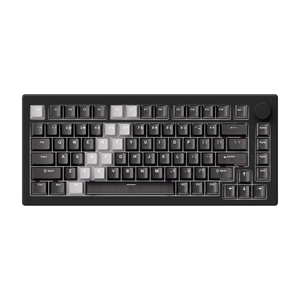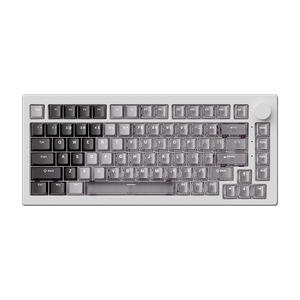What is a Bluetooth mouse?
A Bluetooth mouse is a wireless mouse that connects to a computer using Bluetooth technology. Unlike other wireless mice, a Bluetooth mouse doesn't require an additional receiver, saving on a USB port.
Advantages of the Bluetooth mouse
1. Wireless freedom
A Bluetooth mouse offers a wireless connection, allowing the user to move freely within a larger area without being restricted by a cable. This helps keep your desk tidy and is especially convenient for people who frequently work in different locations.
2. Portability
Bluetooth mice are typically lightweight and compact, making them easy to transport. Whether in a café, the library, or while traveling, you can easily slip them into your bag and use them on the go.
3. Compatibility
These mice are compatible with a wide range of devices, including laptops, tablets, and smartphones. As long as your device supports Bluetooth, you can easily connect the mouse without having to constantly plug and unplug a USB receiver when switching between devices.
4. Battery life
Compared to the 2.4 GHz wireless mouse, the Bluetooth mouse does not require a USB port, which is especially advantageous for MAC users.
Disadvantages of the Bluetooth mouse
1. Potential latency problems
Bluetooth mice can have slightly higher latency than mice with USB receivers. This can be noticeable when gaming or performing tasks that require precise movements, where speed and responsiveness are critical. Therefore, a Bluetooth mouse is sometimes not ideal for gaming.
2. Unstable connection
Bluetooth connections can sometimes be unreliable, especially in areas with weak signals or when multiple Bluetooth devices are used simultaneously. Users may experience occasional connection drops or inconsistent performance.
3. Device compatibility issues
Older devices that don't have built-in Bluetooth may require a Bluetooth adapter, which costs extra and doesn't always work as well as a direct Bluetooth connection.

What is a wireless mouse?
A wireless mouse works without a physical cable. The Bluetooth mouse mentioned above is therefore a wireless mouse. Another type is the 2.4 GHz wireless mouse, which uses radio frequency (RF) to transmit signals to the controlled device.
Now let's take a closer look at the details of the 2.4 GHz wireless mouse. The 2.4 GHz mouse connects via a USB dongle, also called a receiver, which plugs into the computer's USB port. The mouse and dongle are already paired, allowing them to communicate over a specific frequency.
Advantages of the wireless mouse
1. Connection stability
The 2.4 GHz wireless mouse uses a special frequency band and transmission protocol, making its signal less susceptible to interference from other wireless devices. This results in better connection stability, especially in environments with multiple Wi-Fi or Bluetooth devices. In such scenarios, a 2.4 GHz mouse maintains a more reliable connection than Bluetooth mice.
2. Fast transfer speed
With wider bandwidth and greater transmission capacity, 2.4 GHz wireless technology offers faster data transfers, lower latency, and higher responsiveness. This makes it ideal for fast mouse movements, gaming, or tasks that require precise control.
3. Long battery life
Thanks to their efficient power management, 2.4 GHz wireless mice typically offer longer battery life than Bluetooth mice. Some premium models even offer USB charging for added convenience and environmental friendliness.
Disadvantages of the wireless mouse
1. Requires a USB port
The 2.4 GHz wireless mouse must be plugged into a USB receiver to establish a connection, which takes up one of the computer's USB ports. If your device has limited USB ports, this can be inconvenient.
2. The receiver may be lost or damaged
The small USB receiver that comes with the 2.4 GHz wireless mouse is easy to lose or damage. If this happens, you'll need to replace the receiver to continue using the mouse, which requires additional effort.
3. Limited range
The effective range of a 2.4 GHz wireless mouse is typically between 3 and 5 meters. If you need to use the mouse from a greater distance, this could be a limiting factor.

Bluetooth Mouse vs. Wireless Mouse: Key Differences
| feature | Bluetooth mouse | Wireless mouse (with USB dongle) |
| Connection method | Direct Bluetooth connection, no dongle required | Requires a USB dongle for connection |
| Device compatibility | Works with any Bluetooth-enabled device | Works with devices that have USB ports |
| reach | Up to 30 feet (varies depending on Bluetooth version) | Usually 3-5 meters (limited by the receiver) |
| Battery life | Usually longer, more energy efficient | Shorter battery life, depending on usage |
| Port usage | Does not occupy a USB port | Occupies a USB port for the dongle |
| Response time | May be slower (not ideal for gaming) | Faster response time, suitable for gaming |
| Furnishings | Easier setup, no dongle required | Requires installation of the USB receiver |
| Compatibility with mobile devices | Compatible with tablets, smartphones and laptops | Limited compatibility, mainly desktops/laptops |
| Price | Usually more expensive | Usually cheaper |
| Ideal use cases | Portability, multi-device use, travel | Desktop workstations, gaming, single device use |
Which is better for different use cases?
For gaming or high-precision work, the 2.4 GHz wireless mouse is the better choice, especially for performance-intensive games that require fast response times.
For everyday office use or light work, a Bluetooth mouse can be great. It offers convenience, keeps your desk tidy, and saves a USB port, especially with laptops or when using multiple devices.
For portability and travel, a Bluetooth mouse is the preferred choice if you prefer minimalistic design and don't want to use additional accessories like a USB dongle.
Akko Mouse: Wired, 2.4 GHz Wireless, and Bluetooth Connectivity
If you're unsure which mouse to choose or want a mouse that supports multiple connections, the Akko mouse is a great choice. The Akko mouse allows for seamless switching between multiple devices with its wired, 2.4 GHz wireless, and Bluetooth connectivity options. Whether you work on multiple computers, tablets, or even gaming consoles, this mouse can handle it all with ease.
Equipped with a high-performance sensor, the Akko mouse delivers smooth and reliable performance. Its unique design makes it easy to carry, perfect for on-the-go use when you need to quickly switch between different devices.
How do you choose the right mouse for you?
1. Select the sensor
Different sensors offer different performance. The PAW3395 sensor offers up to 26,000 DPI and 650 IPS, while the PAW3950 sensor can deliver up to 30,000 DPI and 750 IPS. For example, the Akko Pulse 01 gaming mouse offers 8 levels of adjustable DPI from 400 to 30,000, allowing you to fine-tune the sensitivity for any task or game.

2. Consider the size and shape
Different mouse sizes and shapes offer different levels of comfort. We recommend choosing the right mouse size and shape based on your hand size and preferred shape.
3. Select the polling rate
The mouse's polling rate describes the frequency of communication between the mouse and the computer per second. You can choose the right polling rate depending on your needs.
4. Consider battery life and charging options
When purchasing a Bluetooth or wireless mouse, you should consider battery life.
Disposable batteries require regular replacement, which can be harmful to the environment. Built-in rechargeable batteries allow you to recharge them regularly.
5. Check user reviews and professional tests
When purchasing a mouse, user reviews and professional tests can help you understand the product's pros and cons. You can also check out reviews on professional testing websites and in trade magazines to learn more about the product's performance, features, and design.
Conclusion
Ultimately, the best connection type depends on your specific needs—whether you prioritize speed, flexibility, or convenience. If you're unsure which mouse to choose, a tri-mode mouse is the perfect solution, as it combines wired, 2.4 GHz wireless, and Bluetooth connectivity into one versatile device. This allows you to enjoy the benefits of all three options and switch between them seamlessly, making it a great all-around choice for any user.















